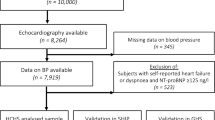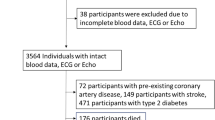Abstract
Left ventricular hypertrophy (LVH) is an independent risk factor for the development of heart failure, coronary heart disease and stroke. LVH develops in response to haemodynamic overload, e.g. hypertension. LVH was originally thought to start as an adaptive and beneficial response required to normalise wall stress. However, this concept has been challenged by recent animal experiments suggesting that any degree of LVH is detrimental for the preservation of cardiac function and survival. If confirmed in humans, these findings imply that an increase in LV mass should be prevented, e.g. by lifestyle or pharmacological interventions. To facilitate and optimise interventions, the SMART Heart study was recently set up to develop a prediction model, also involving single nucleotide polymorphism data, for the identification of subjects at high risk of developing LVH in hypertension. For this purpose 1000 subjects with chronic hypertension will undergo cardiac MR imaging. In addition, this study allows the extrapolation of animal experimental genetic research into the human situation. (Neth Heart J 2007;15:295-8).


Similar content being viewed by others
References
Meijs MF, De Windt LJ, De Jonge N, Cramer MJ, Bots ML, Mali WP, et al. Left ventricular hypertrophy: a shift in paradigm? Curr Med Chem 2007;14:157-71.
Kannel WB, Levy D, Cupples LA. Left ventricular hypertrophy and risk of cardiac failure: insights from the Framingham Study. J Cardiovasc Pharmacol 1987;10(Suppl 6):S135-40.
Levy D, Garrison RJ, Savage DD, Kannel WB, Castelli WP. Prognostic implications of echocardiographically determined left ventricular mass in the Framingham Heart Study. N Engl J Med 1990;322:1561-6.
Brown DW, Giles WH, Croft JB. Left ventricular hypertrophy as a predictor of coronary heart disease mortality and the effect of hypertension. Am Heart J 2000;140:848-56.
Arnold JM, Yusuf S, Young J, Mathew J, Johnstone D, Avezum A, et al. Prevention of Heart Failure in Patients in the Heart Outcomes Prevention Evaluation (HOPE) Study. Circulation 2003; 107:1284-90.
Drazner MH, Rame JE, Marino EK, Gottdiener JS, Kitzman DW, Gardin JM, et al. Increased left ventricular mass is a risk factor for the development of a depressed left ventricular ejection fraction within five years: the Cardiovascular Health Study. J Am Coll Cardiol 2004;43:2207-15.
Devereux RB, Bella JN, Palmieri V, Oberman A, Kitzman DW, Hopkins PN, et al. Left ventricular systolic dysfunction in a biracial sample of hypertensive adults: The Hypertension Genetic Epidemiology Network (HyperGEN) Study. Hypertension 2001; 38:417-23.
Krumholz HM, Larson M, Levy D. Prognosis of left ventricular geometric patterns in the Framingham Heart Study. J Am Coll Cardiol 1995;25:879-84.
Verdecchia P, Schillaci G, Borgioni C, Ciucci A, Gattobigio R, Zampi I, et al. Prognostic value of left ventricular mass and geometry in systemic hypertension with left ventricular hypertrophy. Am J Cardiol 1996;78:197-202.
Dahlof B, Pennert K, Hansson L. Reversal of left ventricular hypertrophy in hypertensive patients. A metaanalysis of 109 treatment studies. Am J Hypertens 1992;5:95-110.
Devereux RB, Dahlof B, Gerdts E, Boman K, Nieminen MS, Papademetriou V, et al. Regression of hypertensive left ventricular hypertrophy by losartan compared with atenolol: the Losartan Intervention for Endpoint Reduction in Hypertension (LIFE) trial. Circulation 2004;110:1456-62.
Perlini S, Muiesan ML, Cuspidi C, Sampieri L, Trimarco B, Aurigemma GP, et al. Midwall mechanics are improved after regression of hypertensive left ventricular hypertrophy and normalization of chamber geometry. Circulation 2001;103:678-83.
Lips DJ, De Windt LJ, van Kraaij DJ, Doevendans PA. Molecular determinants of myocardial hypertrophy and failure: alternative pathways for beneficial and maladaptive hypertrophy. Eur Heart J 2003;24:883-96.
Esposito G, Rapacciuolo A, Naga Prasad SV, Takaoka H, Thomas SA, Koch WJ, et al. Genetic alterations that inhibit in vivo pressure-overload hypertrophy prevent cardiac dysfunction despite increased wall stress. Circulation 2002;105:85-92.
van Oort RJ, van Rooij E, Bourajjaj M, Schimmel J, Jansen MA, van der Nagel R, et al. MEF2 activates a genetic program promoting chamber dilation and contractile dysfunction in calcineurininduced heart failure. Circulation 2006;114:298-308.
van Rooij E, Doevendans PA, de Theije CC, Babiker FA, Molkentin JD, De Windt LJ. Requirement of nuclear factor of activated T-cells in calcineurin-mediated cardiomyocyte hypertrophy. J Biol Chem 2002;277:48617-26.
van Rooij E, Doevendans PA, Crijns HJ, Heeneman S, Lips DJ, van Bilsen M, et al. MCIP1 overexpression suppresses left ventricular remodeling and sustains cardiac function after myocardial infarction. Circ Res 2004;94(3):e18-26.
Simons PC, Algra A, van de Laak MF, Grobbee DE, van der Graaf Y. Second Manifestations of ARTerial disease (SMART) study: rationale and design. Eur J Epidemiol 1999;15:773-81.
Grothues F, Smith GC, Moon JC, Bellenger NG, Collins P, Klein HU, et al. Comparison of interstudy reproducibility of cardiovascular magnetic resonance with two-dimensional echocardiography in normal subjects and in patients with heart failure or left ventricular hypertrophy. Am J Cardiol 2002;90:29-34.
Tsang TS, Barnes ME, Gersh BJ, Bailey KR, Seward JB. Left atrial volume as a morphophysiologic expression of left ventricular diastolic dysfunction and relation to cardiovascular risk burden. Am J Cardiol 2002;90:1284-9.
Judd RM, Wagner A, Rehwald WG, Albert T, Kim RJ. Technology insight: assessment of myocardial viability by delayedenhancement magnetic resonance imaging. Nat Clin Pract Cardiovasc Med 2005;2:150-8.
Mahrholdt H, Wagner A, Judd RM, Sechtem U, Kim RJ. Delayed enhancement cardiovascular magnetic resonance assessment of non-ischaemic cardiomyopathies. Eur Heart J 2005;26:1461-74.
Marwick TH. Measurement of strain and strain rate by echocardiography: ready for prime time? J Am Coll Cardiol 2006;47: 1313-27.
Weidemann F, Broscheit JA, Bijnens B, Claus P, Sutherland GR, Voelker W, et al. How to distinguish between ischemic and nonischemic postsystolic thickening: a strain rate imaging study. Ultrasound Med Biol 2006;32:53-9.
Oh JK, Hatle L, Tajik AJ, Little WC. Diastolic heart failure can be diagnosed by comprehensive two-dimensional and Doppler echocardiography. J Am Coll Cardiol 2006;47(3):500-6.
Author information
Authors and Affiliations
Additional information
Departments of Cardiology and Radiology, University Medical Centre Utrecht, Utrecht, the Netherlands
Julius Centre for Health Sciences and Primary Care, University Medical Centre Utrecht, Utrecht, the Netherlands
Department of Radiology, University Medical Centre Utrecht, Utrecht, the Netherlands
Julius Centre for Health Sciences and Primary Care, University Medical Centre Utrecht, Utrecht, the Netherlands
Department of Cardiology, University Medical Centre Utrecht, Utrecht, the Netherlandson behalf of the SMART Study Group
P.A. Doevendans Department of Cardiology, University Medical Centre Utrecht, PO Box 85500, 3508 GA Utrecht, the Netherlands
Rights and permissions
About this article
Cite this article
Meijs, M.F.L., Bots, M.L., Vonken, J.A. et al. Rationale and design of the SMART Heart study. NHJL 15, 295–298 (2007). https://doi.org/10.1007/BF03086003
Issue Date:
DOI: https://doi.org/10.1007/BF03086003




